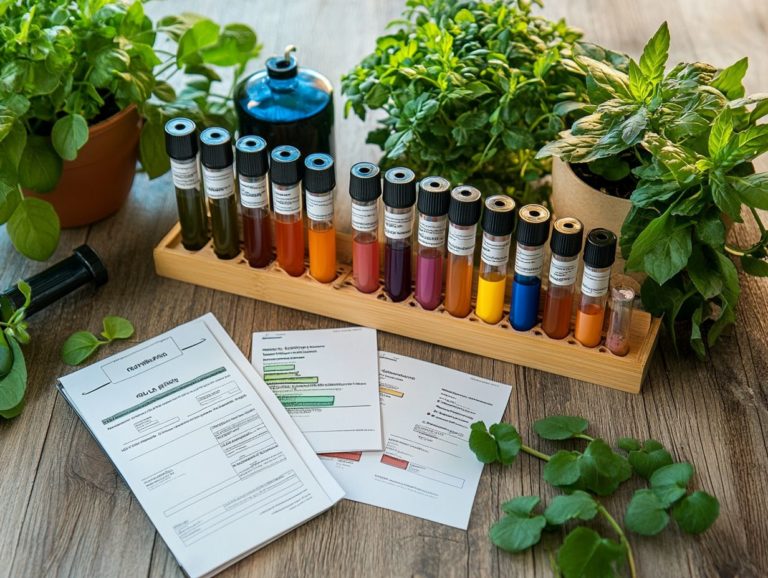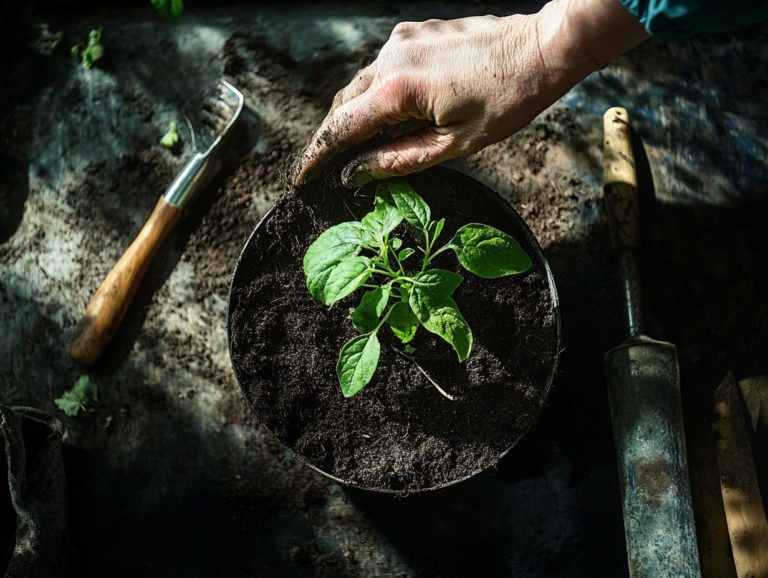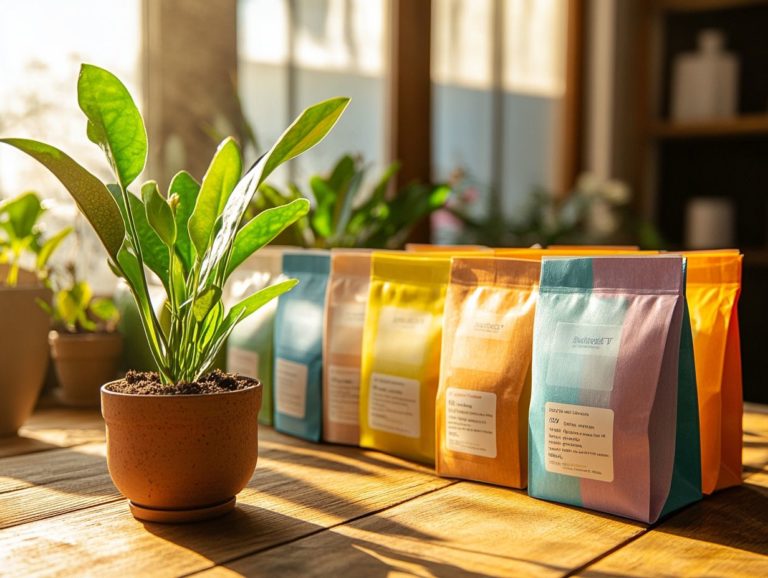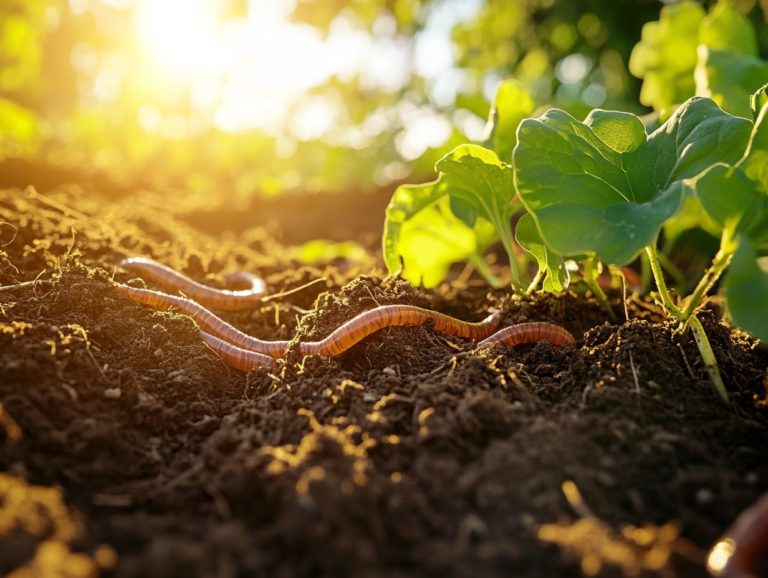5 Essential Nutrients for Indoor Plants
Indoor plants have the remarkable ability to elevate your living space and enhance air quality. However, to truly thrive, they require more than just water and sunlight.
Understanding the essential nutrients such as nitrogen, phosphorus, potassium, calcium, and magnesium is key to cultivating a healthy, vibrant collection of plants.
Let s explore the signs of nutrient deficiency to keep your plants thriving! This article offers insights on how to provide these vital elements, discusses the benefits of utilizing natural fertilizers, outlines the ideal fertilization frequency, and highlights the risks of over-fertilizing.
Prepare to unlock the secrets to nurturing your indoor green companions!
Contents
- Key Takeaways:
- 1. Nitrogen
- 2. Phosphorus
- 3. Potassium
- 4. Calcium
- 5. Magnesium
- What Are the Signs of Nutrient Deficiency in Indoor Plants?
- Frequently Asked Questions
- What are the 5 essential nutrients for indoor plants?
- Why are these nutrients important for indoor plants?
- How can I provide these nutrients to my indoor plants?
- What are the signs of nutrient deficiency in indoor plants?
- How often should I fertilize my indoor plants?
- Can I use natural sources for these important nutrients instead of fertilizers?
Key Takeaways:

- Nitrogen, phosphorus, potassium, calcium, and magnesium are the 5 essential nutrients that indoor plants need for healthy growth.
- Signs of nutrient deficiency in indoor plants include yellowing leaves, stunted growth, and weak stems.
- These nutrients can be provided to indoor plants through natural fertilizers, such as compost or manure, for added benefits.
1. Nitrogen
Nitrogen is an important nutrient that plays a vital role in the growth and health of your indoor plants. It significantly influences their chlorophyll production and overall nutrient absorption, making it crucial for anyone passionate about cultivating vibrant greenery in their space.
This key element is central to photosynthesis. It directly contributes to the formation of chlorophyll the pigment that captures sunlight and fuels your plants’ energy production. Without sufficient nitrogen, you might notice stunted growth and yellowing leaves, clear indicators of nutrient deficiencies.
To support your plants, various fertilizers like Miracle-Gro and Dyna-Gro offer reliable nitrogen sources tailored for different plant types and their growth phases, whether you are nurturing leafy greens or flowering houseplants. It’s also important to understand the role of nutrients in indoor plant soil. Make sure to follow the recommended application rates closely to protect your plants! The right amount can significantly boost the vigor and vibrancy of your plants during both vegetative and blooming stages.
2. Phosphorus
Phosphorus is an essential nutrient that boosts root development and flowering in your indoor plants. This makes it a vital ingredient in fertilizers, especially those tailored for houseplants and flowering specimens, impacting their overall growth and well-being.
In the intricate world of plant nutrient cycles, phosphorus does much more than just strengthen roots. It plays a key role in energy transfer within plants, facilitating essential processes like photosynthesis and nutrient uptake. The NPK ratio representing nitrogen, phosphorus, and potassium highlights the importance of balanced nutrition for achieving optimal plant health.
If you’re looking to enrich your soil, consider incorporating organic fertilizers like Neptune’s Harvest. These natural sources of phosphorus can greatly enhance root growth and encourage vibrant blooms. To learn more about maintaining healthy plants, check out this guide on how to fertilize your indoor plants effectively, ensuring your indoor plants flourish while reducing chemical exposure.
3. Potassium
Potassium is an essential nutrient that supports nutrient absorption and enhances plant health. It plays a pivotal role in the functioning of chlorophyll, which is crucial for photosynthesis and overall growth in your indoor plants.
Potassium also helps your plants resist environmental stressors like droughts and diseases, enabling them to flourish even under less-than-ideal conditions. If you’re diving into container gardening, maintaining the right potassium levels becomes crucial for ensuring your plants remain vibrant and resilient.
Utilizing slow-release fertilizers like Grow More not only provides a steady supply of potassium but also helps sustain nutrient levels over time. By embracing these practices, you can cultivate a thriving garden that withstands challenges and continuously flourishes.
Now that you know the essential nutrients your indoor plants need, why not try these tips? Share your experiences with indoor plant care!
4. Calcium
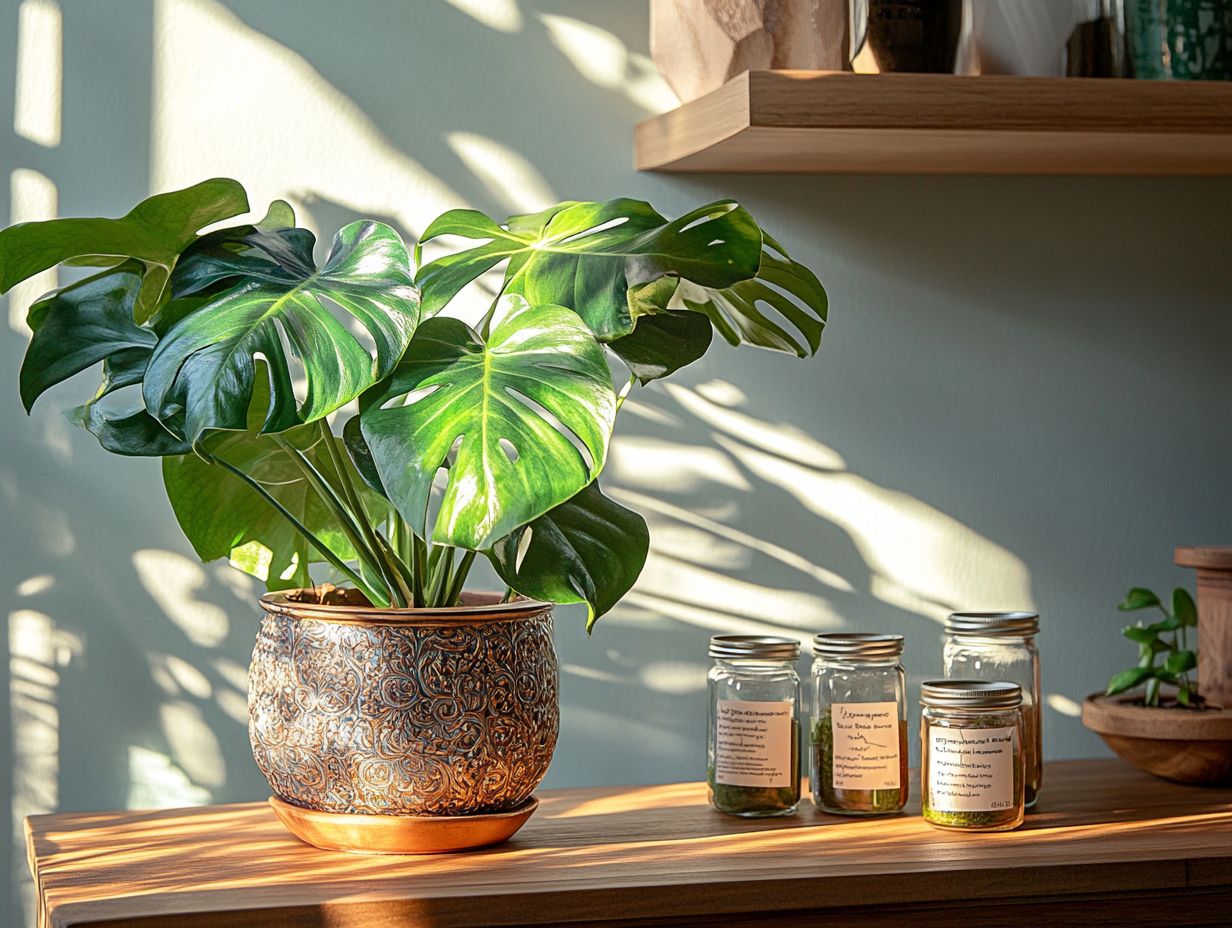
Calcium is often the unsung hero of indoor plant care. It plays a crucial role in nurturing root development and preventing nutrient deficiencies that can lead to lackluster plant health and diminished chlorophyll production. It s simply essential for effective plant care.
This mineral not only fortifies cell walls but also participates in various physiological processes within your plants. Without adequate calcium, you may notice troubling symptoms like blossom end rot and leaf deformation, which can seriously impede growth and resilience.
Testing fertilizers for calcium content is a breeze; a soil test kit can provide valuable insights into the nutrient levels in your soil. If you’re inclined toward organic solutions to enhance your indoor greenery, consider using oyster shell flour, liquid kelp, or certain types of compost to boost calcium levels.
These can effectively lead to healthier plants and vibrant foliage.
5. Magnesium
Magnesium is a crucial element in chlorophyll, and its role in nutrient absorption is vital for the healthy growth of your potted plants and houseplants, especially when you opt for balanced fertilizers like Espoma Organic.
This essential mineral also encourages vibrant green foliage and supports the photosynthesis process, allowing your plants to transform sunlight into energy effectively. Without adequate magnesium, you might notice yellowing leaves a condition known as chlorosis leaving your plants struggling despite the right amounts of water and sunlight.
When choosing balanced fertilizers, be sure to check the nutrient composition for magnesium; it’s key to ensuring optimal plant health. If you’re nurturing potted plants, regularly incorporating magnesium-rich fertilizers or supplements can significantly boost their growth and vitality, resulting in lush, resilient greenery in your indoor space. Additionally, using the right tools can enhance your care routine, so consider exploring 5 essential tools for indoor plant watering to ensure your plants thrive.
What Are the Signs of Nutrient Deficiency in Indoor Plants?
Identifying the signs of nutrient deficiency in your indoor plants is essential if you aim to maintain optimal plant health. Symptoms can vary widely, from yellowing leaves often a result of chlorophyll production issues to stunted growth, which indicates a lack of essential nutrients.
Keep an eye out for signs like wilting foliage; they can suggest inadequate water uptake or insufficient nutrient availability. Meanwhile, browning leaf tips might hint that your plants are craving more potassium.
Regularly monitoring these symptoms enables you to make informed decisions about watering, fertilization, and even the ideal placement of your plants within your home.
By closely observing these indicators, you can tackle immediate concerns while also crafting a proactive nutrient management strategy. Understanding the signs of nutrient deficiency in indoor plants ensures your plants not only survive but thrive beautifully!
How Can One Provide These Nutrients to Indoor Plants?
Providing essential nutrients to your indoor plants can be elegantly achieved through a variety of methods. Consider using organic fertilizers and meticulously monitoring application rates to create a nutrient-rich environment that supports optimal growth.
Organic fertilizers like compost, vermicompost, and seaweed extracts not only enhance the soil but also improve its structure and water retention, fostering healthier root systems. To further support your indoor plants, consider using top soil amendments for healthy indoor plants. These organic options release nutrients gradually, significantly reducing the risk of nutrient burn in sensitive plants.
Testing soil nutrient levels through techniques such as soil sampling and pH testing enables you to make precise adjustments, ensuring the perfect balance of macronutrients and micronutrients.
Understanding the significance of application rates is paramount, as over-fertilization can lead to detrimental effects, while under-fertilization can stifle plant development. Don’t wait until it’s too late act now to boost your plants’ health!
By skillfully combining these elements, you can cultivate a flourishing green space that brings life and vibrancy to your indoor environment.
What Are the Benefits of Using Natural Fertilizers for Indoor Plants?
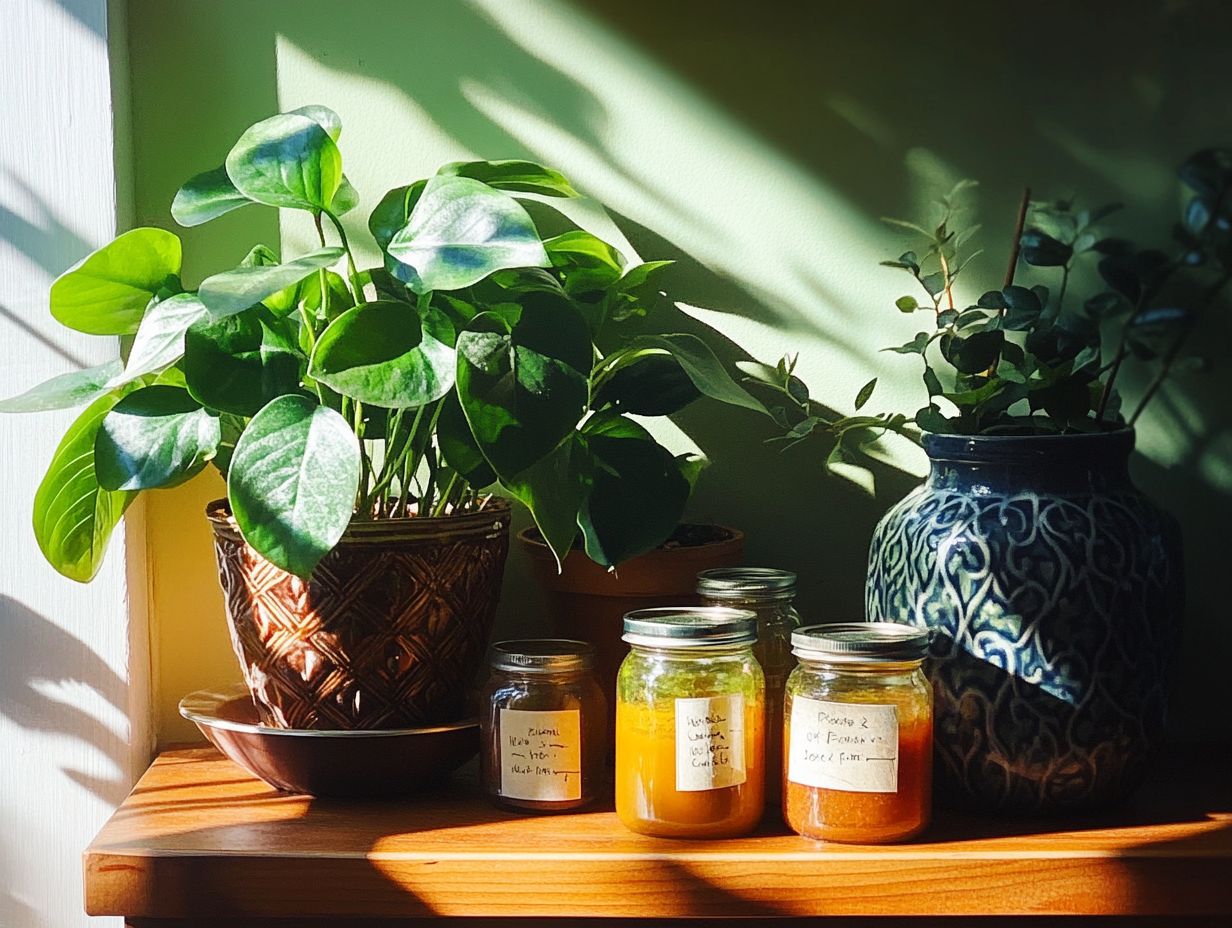
Using natural fertilizers for your indoor plants offers numerous benefits, including improved plant health, enhanced nutrient absorption, and a lower risk of environmental contamination. These organic options not only provide essential nutrients but also support helpful tiny organisms in the soil, leading to a more robust root system and promoting sustainable gardening practices.
This holistic approach fosters vibrant and resilient plants while creating a balanced ecosystem that benefits both you and the environment.
How Often Should Indoor Plants Be Fertilized?
Establishing a consistent fertilizer routine is essential, with frequency varying based on growth phases and plant types. For instance, flowering plants thrive with bi-weekly feedings during blooming, while foliage plants might only need monthly treatments.
Pay close attention to your plants’ needs to see them thrive! Understanding growth stages like active growth in spring versus dormancy in winter will help you adjust the fertilization schedule for optimal plant vitality and blooming potential.
Are There Any Risks of Over-Fertilizing Indoor Plants?
Over-fertilizing can harm your indoor plants, causing issues like nutrient pollution, leaf burn, and stunted growth. Watch for signs such as yellowing leaves or wilting, which may indicate root damage or nutrient toxicity.
To keep your plants thriving, practice moderation in feeding, which benefits both your plants and the broader environment.
Learn how to care for your indoor plants effectively!
Frequently Asked Questions
What are the 5 essential nutrients for indoor plants?

The 5 essential nutrients for indoor plants include nitrogen, phosphorus, potassium, calcium, and magnesium. These nutrients support photosynthesis and root development.
Why are these nutrients important for indoor plants?
These nutrients are vital because they support growth, health, photosynthesis, root development, and the production of flowers and fruits.
How can I provide these nutrients to my indoor plants?
You can provide these nutrients through fertilizers, potting soil, and watering. Use fertilizers specifically formulated for indoor plants to ensure the right balance of nutrients.
What are the signs of nutrient deficiency in indoor plants?
Signs of nutrient deficiency can vary, but common indicators include yellowing or browning leaves, stunted growth, and wilting.
How often should I fertilize my indoor plants?
How often you fertilize indoor plants depends on the plant type and its growth stage.
Generally, fertilize once a month during the growing season. Reduce or stop during winter.
Can I use natural sources for these important nutrients instead of fertilizers?
Absolutely! Natural sources like compost, manure, and compost tea can give your indoor plants the nutrients they crave!
However, using natural sources can make it harder to control nutrient balance compared to fertilizers.

